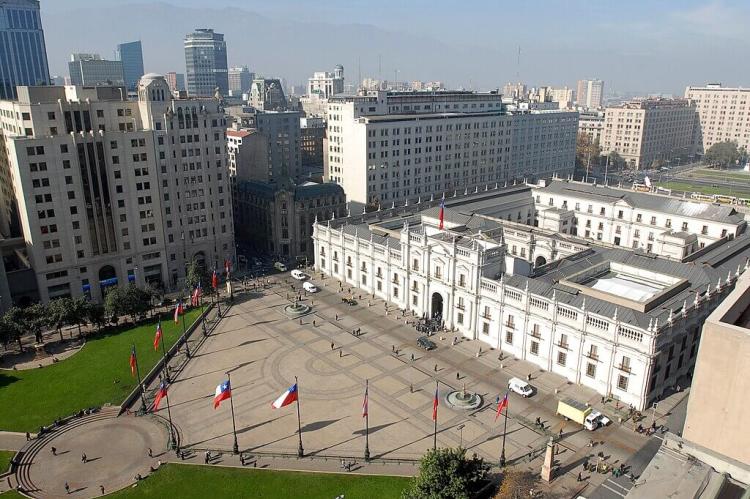La Moneda Palace: Symbol of Chilean Democracy, Resilience, and Civic Heritage
La Moneda Palace, Palacio de la Moneda in Santiago, Chile, is an iconic symbol of Chilean history, politics, and resilience. Originally constructed as a colonial mint house, the palace has witnessed significant historical events, including the transformation of its role into the seat of political power.
La Moneda Palace
A Symbol of Chilean History, Resilience, and Democracy
La Moneda Palace, also known as Palacio de la Moneda, is an iconic symbol of Chilean history, politics, and resilience. Originally constructed as a colonial mint house in the late 18th century, the palace has witnessed significant historical events, including the transformation of its role from a coin-producing facility into the seat of political power.
Historical Background
Designed by Italian architect Joaquín Toesca, construction of La Moneda Palace commenced in 1784, with the building officially opening its doors in 1805 while still under construction. The palace played a crucial role in producing coins for Chile for over a century, serving as the national mint from 1814 to 1929. The architectural elegance of La Moneda reflects the neoclassical style prevalent during its construction, showcasing the influence of Toesca's design.
Presidential Residence and Political Center
In 1845, during President Manuel Bulnes's administration, La Moneda became the official residence and seat of the Chilean government. The palace's significance grew over the years, establishing its presence in the Civic District of downtown Santiago. Plaza de la Constitución, a public square, was constructed in front of the palace in 1930, adding to its political prominence.
The Military Coup of 1973
One of the darkest chapters in La Moneda's history occurred on September 11, 1973, when a military coup led by General Augusto Pinochet ousted the democratically elected President Salvador Allende. The Chilean Air Force bombed La Moneda at the army's request, marking a pivotal moment in the nation's history. President Allende tragically lost his life during the coup, and the palace suffered extensive damage.
Reconstruction and Restoration
The aftermath of the coup necessitated extensive reconstruction and restoration efforts. Completed in March 1981, these projects aimed to repair the damage inflicted during the military intervention. While bullet marks from the coup were preserved as historical reminders, La Moneda emerged from the restoration as a symbol of resilience, showcasing the nation's commitment to democracy.
The "Bunker" and Symbolic Restoration
During the restoration period (1973-1980), an underground office complex, known as the "bunker," was constructed beneath the front square. This space was designed to provide a secure retreat for General Augusto Pinochet in the event of an attack. The symbolic significance of La Moneda as a beacon of democracy is reflected in these restoration efforts, emphasizing the nation's commitment to rebuilding and moving forward.
Presidential Initiatives and Public Accessibility
Under President Ricardo Lagos's administration, La Moneda underwent further transformations. Inner courtyards were opened to the public during specific hours, allowing citizens to engage with the historical and political significance of the palace. Additionally, Morandé 80, a gate rich in symbolism, was restored. This gate was the entrance for Chilean presidents, including President Allende, and became a poignant reminder of the events surrounding the 1973 coup.
Changing of the Guard Ceremony
A traditional changing of the guard ceremony takes place every two days at La Moneda, dating back to the 1850s. Lasting approximately 30 minutes, the ceremony includes a military band, troops on horseback parading into the square, and a display of grandeur. The Carabineros de Chile play a pivotal role in providing the guard unit and band for this ceremonial event, further solidifying the connection between La Moneda and Chile's history.
Constitution Square: A Civic Hub Anchoring La Moneda's Legacy
In 1930, a significant addition to La Moneda's surroundings transformed the area into a civic hub – Constitution Square, or Plaza de la Constitución. This public square in front of La Moneda Palace is pivotal in anchoring the palace's political legacy within the heart of Santiago's Civic District.
Constitution Square was designed to be a central gathering place for citizens, emphasizing the importance of democratic values. Over the years, it has witnessed numerous historical events and public demonstrations, serving as a symbolic space for expressing political and social aspirations.
The square's proximity to La Moneda Palace reinforces its connection to Chilean governance, representing the nation's commitment to constitutional principles. While initially conceived as part of an urban plan to enhance the surroundings of the presidential palace, Constitution Square has evolved into a space that encapsulates the spirit of democracy and civic engagement.
The significance of Constitution Square became particularly pronounced during the military coup of 1973 when the events unfolding in and around the square marked a turning point in Chilean history. The square not only bears witness to the political struggles of the past but also serves as a space for commemoration and reflection on the nation's journey toward democracy.
In the broader context, Constitution Square complements La Moneda Palace by providing an open and accessible public space where citizens can engage with their country's history and political landscape. It stands as a testament to the enduring democratic ideals that form the foundation of Chilean society.
Today, Constitution Square remains a vibrant civic space, hosting public events, protests, and celebrations. Its synergy with La Moneda Palace creates a cohesive narrative that intertwines Chile's journey's historical, political, and civic dimensions. Together, they form an enduring symbol of the nation's commitment to democracy and the resilience of its people in the face of challenges.
Conclusion
La Moneda Palace is a testament to Chile's complex and resilient history. From its origins as a colonial mint to becoming the epicenter of political power, the palace has weathered the storms of military coups and reconstruction efforts. Its architectural magnificence, coupled with its historical significance, symbolizes the nation's commitment to democracy and serves as a poignant reminder of the challenges faced and overcome by the Chilean people. La Moneda continues to be a beacon of resilience, reflecting the enduring spirit of the Chilean nation.


